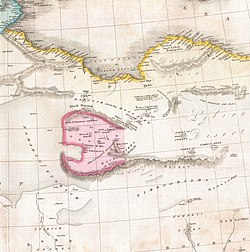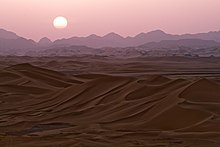| Fezzan
ⴼⵣⵣⴰⵏ (Berber languages) فَزَّان (Arabic) | |
|---|---|
| Region | |
 The Fezzan region (shown in pink), at the beginning of the 19th century The Fezzan region (shown in pink), at the beginning of the 19th century | |
| Country | |
| Capital | Sabha |
Fezzan (UK: /fɛˈzɑːn/ fez-AHN, US: /fɛˈzæn, fəˈzæn/ fez-AN, fə-ZAN; Berber languages: ⴼⵣⵣⴰⵏ, romanized: Fezzan; Arabic: فَزَّان, romanized: Fazzān [fazˈzaːn]; Latin: Phazania) is the southwestern region of modern Libya. It is largely desert, but broken by mountains, uplands, and dry river valleys (wadis) in the north, where oases enable ancient towns and villages to survive deep in the otherwise inhospitable Sahara Desert. The term originally applied to the land beyond the coastal strip of Africa proconsularis, including the Nafusa and extending west of modern Libya over Ouargla and Illizi. As these Berber areas came to be associated with the regions of Tripoli, Cirta or Algiers, the name was increasingly applied to the arid areas south of Tripolitania.
After the 1934 formation of Libya, the Fezzan province was designated as one of the three primary provinces of the country, alongside Tripolitania province to the north and Cyrenaica province to the northeast.
Etymology
In Berber languages, Fezzan (or ifezzan) means "rough rocks". Fezzan could also be a derivation from the region's Greek name Phasania or Phazania, which may mean "the country of the pheasants".
Geography

Fezzan is crossed in the north by the ash-Shati Valley (Wadi Al Shatii) and in the west by the Wadi Irawan. These two areas, along with portions of the Tibesti Mountains crossing the Chadian border and a sprinkling of remote oases and border posts, are the only parts of the Fezzan able to support settled populations. The large dune seas known as ergs of the Idehan Ubari and the Idehan Murzuq cover much of the remaining land of Fezzan.
History
| This section needs additional citations for verification. Please help improve this article by adding citations to reliable sources in this section. Unsourced material may be challenged and removed. Find sources: "Fezzan" – news · newspapers · books · scholar · JSTOR (September 2022) (Learn how and when to remove this message) |
From the 5th century BCE to the 5th century CE, Fezzan was home to the Garamantes, who operated the Trans-Saharan trade routes successively between Carthage and the Roman Empire in North Africa and Sahelian states of west and central Africa.

The Roman generals Septimus Flaccus in 19 BCE and Suetonius Paulinus in 50 CE led small-scale military expeditions into the northern reaches of the Sahara, and the Roman explorer Julius Maternus traveled there in early 1st century CE. Paulinus reached Fezzan and went further south.
With the end of the Roman Empire and the following commercial crisis, Fezzan began to lose importance. The population was greatly reduced due to the desertification process of the Sahara during the early Middle Ages.
During the 13th and 14th centuries, the Fezzan became a part of the Kanem Empire, which extended as far as Zella, Libya. Wars against the Kanem–Bornu Empire in the early sixteenth century led to the founding of the Awlad Muhammad dynasty, with Murzuk becoming the capital of Fezzan. Around 1565 it was ruled by Muhammad ibn al-Muntasir.
The Ottoman rulers of North Africa asserted their control over the region in the 17th century. In the reign of Abdulhamid II (1876–1909) Fezzan was used as a place of political exile for Young Turks because it was the most remote province from Istanbul.
Beginning in 1911, Fezzan was occupied by Italy. However, Italy's control of the region was precarious until at least 1923, with the rise of Benito Mussolini. The Italians were resisted in their early attempts at conquest by tribal Arab adherents to the militant Sanusiya Sufi religious order. The Tuareg clans of the region were only pacified by European expansion shortly before the Second World War, and some of them collaborated with the Italian Army in the North African Campaign. Free French troops occupied Murzuk, a chief town of Fezzan, on 16 January 1943, and proceeded to administer Fezzan with a staff stationed in Sabha, forming the Military Territory of Fezzan-Ghadames.
French administration was largely exercised through Fezzan notables of the family of Sayf Al Nasr. Disquieting to the tribes in western Fezzan was the administrative attachment of Ghat, and its surrounding area, to French-ruled Algeria. However, when the French military control ceased in 1951, all of Fezzan became part of the Kingdom of Libya.
Fezzan was a stronghold for Libyan leader Muammar Gaddafi through much of the 2011 Libyan Civil War, though starting in July, anti-Gaddafi forces began to gain ground, taking control of the region's largest city of Sabha in mid-to-late September.
The LF country code (.lf) was reserved "on behalf" of Libya Fezzan (for an "indeterminate period of time") by the International Organization for Standardization (ISO).
There are oil wells in Fezzan capable of producing 400,000 barrels per day, but oil companies fly in staff from northern Libya. The local tribes are not getting any money from the oil trade, and so have turned to smuggling migrants from other parts of Africa, which is feeding the European migrant crisis and is a $1 billion per year industry.
See also
- List of colonial heads of Fezzan
- Postage stamps and postal history of Fezzan and Ghadames
- List of French possessions and colonies
- Germa Museum
- Fezzan-Ghadames (French Administration)
- Fazzan Basin
References
- ^ "Fezzan". Collins English Dictionary. HarperCollins. Retrieved 26 July 2019.
- "Fezzan". Lexico UK English Dictionary. Oxford University Press.
- "Fezzan". The American Heritage Dictionary of the English Language (5th ed.). HarperCollins. Retrieved 26 July 2019.
- Krais, Jakob (2019). "Fazzān". Encyclopaedia of Islam (3rd ed.).
- The Arabic Amazigh dictionary / 3 volumes/ published by the Academy of the Kingdom of Morocco. (Dictionnaire bilingue arabe-amazigh, tome 1 (1990), tome 2 (1996), tome 3 (1999), Publications de l'Académie marocaine.)
- Présence africaine. Editions du Seuil, 1975; p. 477.
- Libia. Accessed 31 August 2022.
- Fezzan profile, temehu.com. Accessed 31 August 2022.
- deGraft-Johnson (1954) African Glory, pg. 26
- Goodchild, R. G. (June 1952). "Mapping Roman Libya". The Geographical Journal. 118 (2): 142–152. doi:10.2307/1791944. ISSN 0016-7398. JSTOR 1791944.
- Corpus of early Arabic sources for west African history pg. 259-60
- Jön Türklerin Korkulu Rüyası: Fizan denen şu yer! (tr) Archived 15 September 2012 at the Wayback Machine
- Ryan, Eileen. "Italy and the Sanusiyya: Negotiating Authority in Colonial Libya, 1911-1931, academiccommons.columbia.edu. Accessed 31 August 2002.
- ^ Berry, LaVerle Bennette "Chapter 1 – Historical Setting -World War II and Independence – Allied Administration" Area Handbook for Libya (1987 edition) Federal Research Division, Library of Congress, Washington, D.C.; available at: A Country Study: Libya, accessed 17 May 2009.
- Fezzan: French occupation, dcstamps.com. Accessed 31 August 2022.
- Wedeman, Ben (20 September 2011). "Government forces enter Libya's Sabha, to cheers". CNN. Retrieved 20 September 2011.
- "ISO 3166-1 Decoding Table". ISO. 2012.
LF – Libya Fezzan – indeterminately reserved
- "Why the number of migrants crossing the Mediterranean is falling". The Economist. 8 September 2017. Retrieved 8 September 2017.
External links
![]() Media related to Fezzan at Wikimedia Commons
Media related to Fezzan at Wikimedia Commons
- Map from Google showing a large area of Fezzan and its important cities.
- Worldstatesmen.org's History and list of rulers of Fezzan.
- Hostkingdom.net's History and list of rulers of Fezzan.
- Lexiorient.com's article on Fezzan.
| Historical regions of Libya | |||
|---|---|---|---|
26°19′58″N 13°25′31″E / 26.3328°N 13.4253°E / 26.3328; 13.4253
Categories: